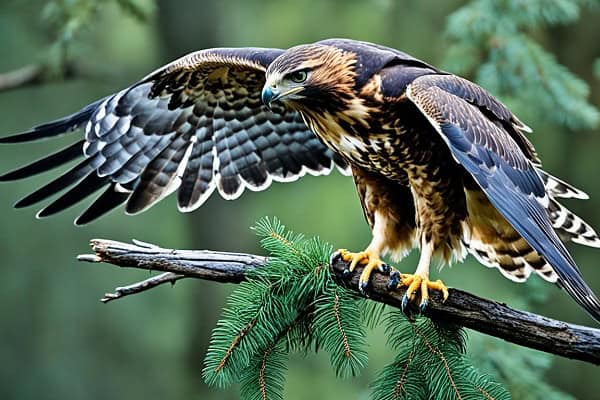9 Types of Hawks in Pennsylvania (ID Guide)
Did you know Pennsylvania has over a dozen types of hawks species, with nine being common? These birds of prey are vital to our ecosystems. They help control rodent populations and keep nature in balance. This guide will show you the key traits, homes, and behaviors of Pennsylvania’s hawks.
If you love birdwatching or just enjoy nature, this guide is for you. It’s designed to deepen your knowledge and love for these amazing raptors. Let’s explore the fascinating world of hawks in Pennsylvania together!
Introduction to Hawks in Pennsylvania
Hawks in Pennsylvania are a sight to behold with their amazing flying skills and hunting prowess. These birds of prey are key to the ecosystem, keeping rodent numbers in check. They thrive in various habitats like forests, fields, and wetlands, making them easy to spot.
While exploring Pennsylvania, you might see different hawk species. The state’s many natural areas are perfect for birdwatching. Hawks are not just beautiful; they also help keep ecosystems healthy. Seeing a hawk in flight is an unforgettable moment for nature lovers.
This article uses eBird data to show the most common hawks in Pennsylvania. It talks about their behaviors and where they live. Pennsylvania is a great place for birdwatchers to see these amazing raptors.
Most Common Hawks Found in Pennsylvania
In Pennsylvania, many hawk species catch the eye of bird watchers and nature lovers. These common hawks show a wide range of diversity and play a big role in the environment. You can see them flying high or sitting in trees, each adding to the beauty of the sky.
Here are some of the most common hawks you might see:
- Red-tailed Hawk – This bird is easy to spot because of its reddish-brown tail. It’s found all over the state.
- Cooper’s Hawk – A medium-sized hawk, it has a short tail and is known for its bold hunting.
- Sharp-shinned Hawk – Small but agile, this hawk is great at moving through the trees in wooded areas.
- Red-shouldered Hawk – You’ll know it by its loud call and beautiful feathers. It lives near wetlands and forests.
- Broad-winged Hawk – A migratory bird, it’s easy to spot because of its wide wings. You’ll see it in large groups during its travels.
Each hawk is important to Pennsylvania’s ecosystem. Watching them helps us appreciate the state’s rich wildlife. Birdwatchers enjoy spotting these hawks and learning about their lives and homes.
1. Red-tailed Hawk
- Scientific name: Buteo jamaicensis
- Life span: 10-15 years
- Size: (50-65 cm)
- Weight: (900-1460 g)
- Wingspan: (114-133 cm)
The Red-tailed Hawk, known scientifically as Buteo jamaicensis, is a well-known bird of prey in North America. It has a big, sturdy body and unique features that make it popular among bird lovers. Learning how to identify it will help you see these amazing birds in nature.

Identification Characteristics
When trying to identify a Red-tailed Hawk, look for certain key features. This bird is about 19 inches long and has a wingspan of almost 49 inches. It has a reddish-brown tail with dark streaks on its pale belly. Its broad, square-shaped wingtip is easy to spot as it flies through the sky. Also, listen for its loud call, a sharp “keeeyah,” in open areas.
Habitat and Behavior
Red-tailed Hawks live in many places in Pennsylvania, including open fields, woods, and even near homes. They like to sit high in trees or on cliffs, looking for food. They are experts at soaring, using rising air currents to stay aloft while searching for small animals and other birds. Their sharp vision lets them hunt from high up. They build big nests from sticks and often come back to the same spot every year.
2. Cooper’s Hawk
- Scientific name: Accipiter cooperii
- Life span: 12 years
- Size: (37-39 cm)
- Weight: (220-410 g)
- Wingspan: (62-90 cm)
The Cooper’s Hawk, known scientifically as Accipiter cooperi, is a bird that many bird lovers want to spot. It’s known for its unique looks and actions. This hawk is a big part of Pennsylvania’s bird world.
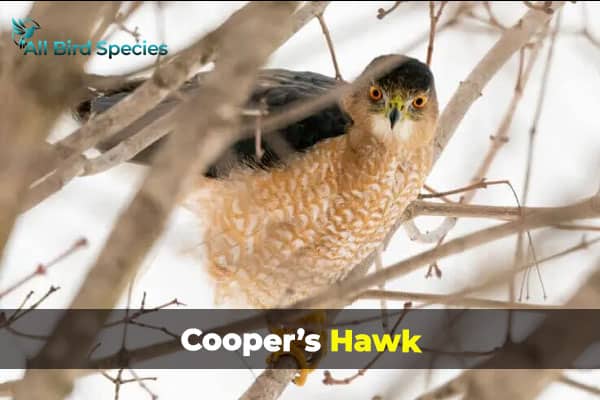
Identification Characteristics
The Cooper’s Hawk is easy to spot when you’re trying to identify hawks. Adults are about 16.5 inches long and have a wingspan of 31 inches. They have a slate gray back and reddish chest bars. Their long, rounded tails help them move through the air with ease, making them great hunters.
Another way to tell the Cooper’s Hawk apart is by its sound. It makes a loud “kek kek kek kek kek!” call during breeding season. Seeing these traits in nature can deepen your respect for this amazing bird.
| Characteristic | Description |
|---|---|
| Length | Approximately 16.5 inches |
| Wingspan | About 31 inches |
| Back Color | Slate gray |
| Chest Pattern | Reddish barring |
| Tail Shape | Long and rounded |
| Call | “Kek kek kek kek kek!” |
3. Red-shouldered Hawk
- Scientific name: Buteo lineatus
- Life span: Up to 12 years
- Size: (45-50 cm)
- Weight: (350-740 g)
- Wingspan: (100-122 cm)
The Red-shouldered Hawk, known as Buteo lineatus, is a beautiful bird found in Pennsylvania. Spotting one can be thrilling, especially if you know what to look for. They have unique features and live in certain places.
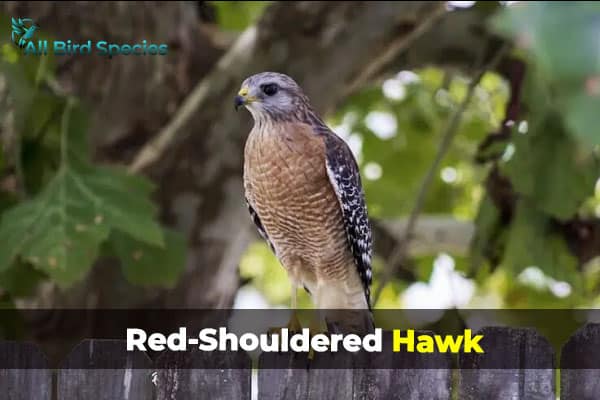
Identification Characteristics
To identify a Red-shouldered Hawk, look for its bright reddish-orange belly and black-and-white wings. Adults are about 17 inches long and have a wingspan of around 40 inches. They are known for their loud calls, which fill the forests they call home.
Habitat Preferences
Red-shouldered Hawks love wooded and semi-wooded areas, especially near wetlands or rivers. These places are perfect for hunting snakes and small mammals. In the spring, they build their nests in tall trees. This gives them a great view of hunting and keeping their young safe.
| Characteristic | Description |
|---|---|
| Species | Buteo lineatus |
| Length | Approximately 17 inches |
| Wingspan | About 40 inches |
| Color | Reddish-orange underparts, black-and-white wings |
| Habitat | Wooded areas near wetlands or riverbanks |
| Diet | Snakes and small mammals |
Hawks in other Regions:
4. Sharp-shinned Hawk
- Scientific name: Accipiter striatus
- Life span: 5 years
- Size: (24-34 cm)
- Weight: (87-218 g)
- Wingspan: (43-56 cm)
The Sharp-shinned Hawk, known as the Accipiter striatus, is a bird that captures the interest of birdwatchers and nature lovers. These small predators live in various woodlands and are great at flying through dense areas to catch their food. Knowing how to identify them helps you spot these birds in the wild.

Identification Characteristics
Identifying a Sharp-shinned Hawk is thrilling, thanks to their unique looks. Here are some key features:
- Size: They are about 11 inches long, making them the smallest hawks in North America.
- Wingspan: Their wingspan is around 23 inches, which helps them fly quickly and easily.
- Coloration: Sharp-skinned hawks have blue-gray tops and orange bars on their bottoms.
- Tail: They have a square-shaped tail, which is a clear sign of this hawk.
- Flight Style: Their fast and agile flight makes them excellent hunters.
These traits are crucial for identifying the Sharp-skinned hawks in the wild. They hunt by ambushing small birds in gardens, making them hard to spot.
5. Broad-winged Hawk
- Scientific name: Buteo platypterus
- Life span: 12 years
- Size: (34-44 cm)
- Weight: (265-560 g)
- Wingspan: (81-100 cm)
When the Buteo platypterus flies overhead, it’s hard not to be curious about its migration. The Broad-winged Hawk is famous for its stunning fall migrations. These hawks form large groups in the sky, creating a beautiful sight.
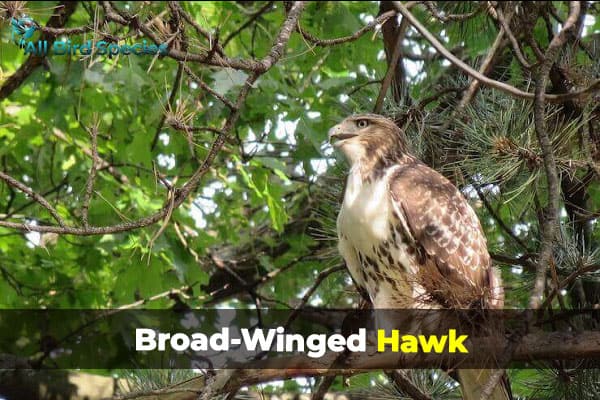
Migration Patterns
The Broad-winged Hawk’s migration is a remarkable journey. They move from North America to Central and South America in winter. They start their journey in late summer, gathering in large numbers along their migration paths.
This gathering creates a stunning sight for bird lovers and nature fans. The hawks use thermal updrafts to soar and save energy during their long journey. They change their diet with the seasons, adapting to their new habitats.
Watching the Broad-winged Hawk during migration is a treat. It shows how these birds are resilient and adaptable.
6. Northern Harrier
- Scientific name: Circus hudsonius
- Life span: Up to 12 years
- Size: (45-50 cm)
- Weight: (350-740 g)
- Wingspan: (100-122 cm)
The Northern Harrier Hawks, known as Circus Hudsonius, is a bird you might see in Pennsylvania. It’s known for its elegant flight and special hunting ways. Learning about its unique traits helps you spot it better and enjoy birdwatching more.

Distinctive Features
This bird is about 18 inches long and has a wingspan of around 43 inches. It has long wings and a white rump, making it easy to spot. Males have a light gray color, while females are brown. This difference helps in identifying the bird.
While hunting, the Northern Harrier flies low over fields and marshes. This lets it find small mammals and birds to eat. Watching it hunt can teach you a lot about this interesting bird.
7. Rough-legged Hawk
- Scientific name: Buteo lagopus
- Life span: Up to 15 years
- Size: (46-51 cm)
- Weight: (680-1470g)
- Wingspan: (132-137 cm)
The Rough-legged Hawk, or Buteo lagopus, is a striking bird that graces the skies of Pennsylvania during the winter months. This species is well-known for its remarkable adaptations that enable it to thrive in cold climates. With its long wingspan, which can reach up to 53 inches, the Rough-legged Hawk presents a commanding presence while soaring in search of prey.
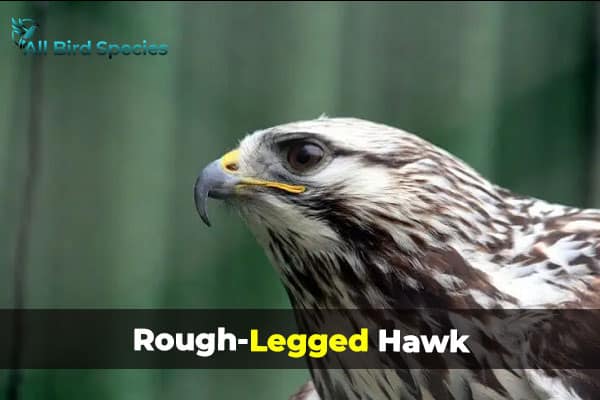
Winter Migration
As temperatures drop, hawk migration becomes apparent with the arrival of the Rough-legged Hawk in Pennsylvania. These birds migrate from their breeding grounds in the Arctic, seeking warmer climates and abundant food sources. Their distinctive downy feathers provide excellent insulation, making them resilient against frigid conditions.
Diligently hunting in open fields, this hawk primarily preys on small mammals. By adopting a hunting strategy that allows for gliding and hovering, the Rough-legged Hawk capitalizes on its keen eyesight. It’s not uncommon to spot these majestic birds perched on fence posts or in trees, surveying their surroundings for potential meals.
8. Swainson’s Hawk
- Scientific name: Buteo swainsoni
- Life span: Up to 15 years
- Size: (46-56 cm)
- Weight: (650-1,100 g)
- Wingspan: (119-150 cm)
Swainson’s Hawk is a large bird of prey that migrates long distances. It breeds in the open plains and grasslands of western North America. These hawks have a dark brown back, a reddish-brown chest, and a pale belly. Their long, pointed wings help them travel to South America for the winter.
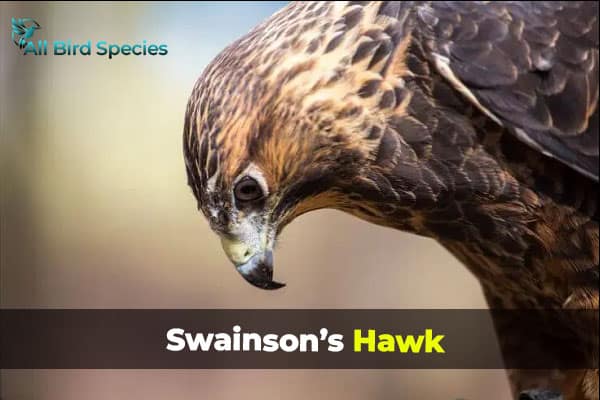
During migration, Swainson’s Hawks fly in large groups, often seen soaring on warm air currents. In Pennsylvania, they are rare and usually spotted only during migration. Their broad wings and long tails make them excellent at gliding over open areas.
Swainson’s Hawks like open spaces for nesting and often choose single trees or shrubs in prairies, deserts, or farmland. They build their nests from sticks, lining them with soft materials like grass, bark, and leaves to keep their eggs and chicks comfortable.
Both male and female hawks help build the nest and take care of the young. These nests are usually placed at medium heights, providing some protection while staying close to open areas for hunting.
| Feature | Description |
|---|---|
| Wingspan | Up to 53 inches |
| Length | Approximately 22 inches |
| Feather Adaptations | Downy feathers for insulation |
| Migration Pattern | Moves from Arctic breeding grounds to Pennsylvania |
| Primary Prey | Small mammals |
Hawks in Pennsylvania: Conservation Status
The conservation status of hawks in Pennsylvania shows a complex relationship between these birds and their environment. The Migratory Bird Treaty Act gives them legal protection. Hawks face many challenges, and conservation efforts aim to help them.
Habitat loss is a big problem. Urban growth, farming, and cutting down trees reduce the space these birds need. Humans also disturb them, especially when they are nesting.
There are ongoing efforts to watch and manage hawk populations. Agencies, groups, and volunteers work together to protect wildlife in Pennsylvania. Studies show that more awareness and community help can lead to better conservation results.
Here is a table that shows the current conservation status of some hawk species in Pennsylvania:
| Hawk Species | Conservation Status | Threats | Conservation Efforts |
|---|---|---|---|
| Red-tailed Hawk | Least Concern | Habitat loss, vehicle strikes | Breeding programs, public education |
| Cooper’s Hawk | Stable | Urbanization, pesticide exposure | Monitoring populations, community outreach |
| Broad-winged Hawk | Concerning | Deforestation, climate change | Habitat protection, research initiatives |
Learning about these aspects helps you appreciate the hawks in your area more. Joining in on Pennsylvania wildlife conservation can make a big difference. It can help these birds and increase the area’s biodiversity.
Check our Previous Articles:
| Birds of the African Savanna |
| Hawks in North Carolina |
| Are Black Peacock Real or Fake? |
| Yellow Birds With Black Wings |
| How to Stop Birds from Chirping |
Wrapping Up…
Hawks in Pennsylvania show how rich our environment is and highlight their important roles. From the common Red-tailed Hawk to the rare Northern Harrier, they let us see wildlife in its natural setting. Learning about their behavior and homes makes birdwatching more rewarding and helps us appreciate nature’s balance.
Want to improve your birdwatching? Try visiting state parks, wildlife refuges, or open fields in the early morning or late afternoon. The hawks are most active then. Keep an eye on the sky for these hunters soaring above. Using binoculars can make your birdwatching even better.







